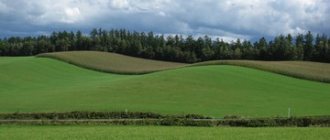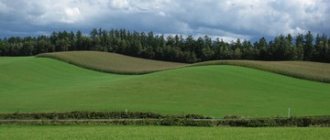ST 102 ZK RF
1. Lands of the water fund include lands:
1) covered by surface waters concentrated in water bodies;
2) occupied by hydraulic engineering and other structures located on water bodies.
2. On lands covered by surface water, the formation of land plots is not carried out.
3. For the purpose of construction of reservoirs and other artificial water bodies, land reservation is carried out.
4. The procedure for the use and protection of water fund lands is determined by this Code and water legislation.
What it is?
Water fund lands are the bottom and adjacent lands of surface water bodies, both natural and man-made.
The legislator considers a surface water body as a single complex system consisting of a land plot, the waters covering it, and lands adjacent to the coastline.
Essential features of the object
- Hydraulic relationship with the natural environment. Completely isolated bodies of water, for example, swimming pools, water tanks, regardless of their volume and location, do not belong to water bodies.
- Consistency. Temporary accumulations of water (for example, as a result of rainfall, river flooding, snow melting) are not considered water bodies by law.
- Part of the water fund. The water body must be included (or must be included) in the state water register. For example, if an artificial fish pond is registered as property, then it will be considered by law as an object not of water, but of civil and other legal relations.
Only surface water bodies can include water fund lands. Groundwater bodies include underground waters that are in hydraulic connection and the rocks that contain them, while the plot of land in the depths of which they are concentrated may belong to another category of land, for example, for agricultural purposes.
Principles of transfer and withdrawal from the fund
The legal regime of water fund lands is established taking into account that as many of these territories as possible are in federal ownership. A private or similar legal entity, as well as a municipality, can only transfer ownership of a small reservoir or pond with the adjacent territory if it belongs to these persons on a private basis. Russian legislation today provides for the possibility of forced alienation of such property for the needs of the state, for example, when individual lands, being in different ownership, cannot exist separately.
In accordance with the norms of Federal Law No. 172 in force today, land that is documented to be in the real ownership of non-state structures can be quite legally seized and in the process transferred to another category. That is, initially land that did not belong to the water fund can be included in it and subsequently withdrawn if this is necessary for the state. Of course, financial compensation is provided for the owner whose property is seized. Before this, the owner must be notified of such a decision in advance and officially, as required by the same Federal Law.
Concept and general characteristics
Land Code of the Russian Federation in Art. 102 includes in the water fund, in addition to lands occupied directly by water bodies, also adjacent lands necessary for the rational use of water resources or protection from the harmful effects of water.
These include water protection zones and territories occupied by special hydraulic structures and complexes: pumping stations, sewage treatment plants, dams, dikes, ship lifts, berths (piers), jetties, spillways, water intakes, bridges, shipping locks, fish protection and fish passage structures, bank protection and other designs.
What areas fall into this category?
So, within the water fund two types of land can be distinguished:
- Lands that are constantly covered with water (they are also called water-covered). They make up about 99% of the lands of the water fund. These are lands occupied by rivers, lakes, inland and territorial seas (and their individual parts, such as bays, bays, estuaries, etc.), reservoirs, canals, swamps, glaciers and snowfields (with the exception of tundra and forest-tundra natural zones) .
- Lands adjacent to water bodies. Coastal strips, allotment strips of canals and reservoirs, security zones, land plots adjacent to reservoirs allocated for the installation of water intakes, hydraulic engineering and water management structures.
Reference! A water body, in conjunction with the hydraulic engineering complex installed on it, forms a single water management system.
The boundaries of a surface water body are determined as follows:
- for seas - along the line of maximum ebb;
- for rivers and lakes - according to the average long-term water level;
- for ponds and reservoirs - according to the normal water level, not covered with ice;
- for swamps - along the boundaries of peat deposits.
The shoreline of a public surface water body is also intended for public use (Part 6, Article 6 of the RF CC). The law prohibits the privatization of land within the coastal strip, as well as areas on which there are ponds, flooded quarries, within the boundaries of public areas (Clause 8 of Article 27 of the Land Code of the Russian Federation).
Federal Law No. 74-FZ of June 3, 2006
Water Code of the Russian Federation (with amendments and additions)
Page 1 / 7
Output document: entire pages
- Chapter 1. General provisions
- Chapter 2. Ownership and other rights to water bodies
- Chapter 3. Water use agreement. Decision to provide a water body for use
- Chapter 4. Management in the field of use and protection of water bodies
- Chapter 5. Water use
- Chapter 6. Protection of water bodies
- Chapter 7. Responsibility for violation of water legislation
Adopted by the State Duma on April 12, 2006
Approved by the Federation Council on May 26, 2006
Chapter 1. GENERAL PROVISIONS
Article 1. Basic concepts used in this Code
For the purposes of this Code, the following basic concepts are used:
- water area - a body of water within natural, artificial or conventional boundaries;
- water management - activities in the field of study, use, protection of water bodies, as well as prevention and elimination of the negative impact of water;
- water resources - surface and underground waters that are located in water bodies and are used or can be used;
- water body - a natural or artificial reservoir, watercourse or other object, the permanent or temporary concentration of water in which has characteristic forms and characteristics of the water regime;
- water regime - change over time in the level, flow and volume of water in a water body;
- water fund - a set of water bodies within the territory of the Russian Federation;
- water disposal - any discharge of water, including waste water and (or) drainage water, into water bodies;
- water user - an individual or legal entity who has been granted the right to use a water body;
- water consumption - water consumption from water supply systems;
- water supply - supply of surface or groundwater to water consumers in the required quantity and in accordance with target indicators of water quality in water bodies;
- water management system - a complex of water bodies and hydraulic structures intended to ensure the rational use and protection of water resources;
- water management area - a part of a river basin that has characteristics that make it possible to set limits for the intake (withdrawal) of water resources from a water body and other parameters for the use of a water body (water use);
- drainage water - water, the removal of which is carried out by drainage structures for discharge into water bodies;
- use of water bodies (water use) - use of water bodies in various ways to meet the needs of the Russian Federation, constituent entities of the Russian Federation, municipalities, individuals, legal entities;
- water depletion - constant reduction in reserves and deterioration in the quality of surface and groundwater;
- negative impact of water - flooding, flooding, destruction of the banks of water bodies, swamping and other negative impacts on certain territories and objects;
- protection of water bodies - a system of measures aimed at preserving and restoring water bodies;
- river basin - a territory from which surface water flows through connected reservoirs and watercourses into the sea or lake;
- wastewater - water that is discharged into water bodies after their use or the drainage of which is carried out from a contaminated area.
Article 2. Water legislation
1. Water legislation consists of this Code, other federal laws and laws of the constituent entities of the Russian Federation adopted in accordance with them.
2. The rules governing relations on the use and protection of water bodies (water relations) and contained in other federal laws and laws of the constituent entities of the Russian Federation must comply with this Code.
3. Water relations may also be regulated by decrees of the President of the Russian Federation, which should not contradict this Code or other federal laws.
4. The Government of the Russian Federation issues regulatory legal acts regulating water relations, within the powers determined by this Code, other federal laws, as well as decrees of the President of the Russian Federation.
5. Federal executive bodies authorized by the Government of the Russian Federation issue regulatory legal acts regulating water relations in cases and within the limits provided for by this Code, other federal laws, as well as decrees of the President of the Russian Federation and decrees of the Government of the Russian Federation.
6. On the basis of and in pursuance of this Code, other federal laws, other regulatory legal acts of the Russian Federation, laws of the constituent entities of the Russian Federation, executive authorities of the constituent entities of the Russian Federation, within the limits of their powers, can issue regulatory legal acts regulating water relations.
7. On the basis of and in pursuance of this Code, other federal laws, other regulatory legal acts of the Russian Federation, laws and other regulatory legal acts of the constituent entities of the Russian Federation, local government bodies, within the limits of their powers, may issue regulatory legal acts regulating water relations.
Article 3. Basic principles of water legislation
Water legislation and regulations issued in accordance with it are based on the following principles:
- the importance of water bodies as the basis of human life and activity. Regulation of water relations is carried out based on the idea of a water body as an important component of the environment, a habitat for objects of flora and fauna, including aquatic biological resources, as a natural resource used by humans for personal and domestic needs, economic and other activity, and at the same time as an object of property rights and other rights;
- priority of protecting water bodies over their use. The use of water bodies should not have a negative impact on the environment;
- preservation of specially protected water bodies, the restriction or prohibition of the use of which is established by federal laws;
- targeted use of water bodies. Water bodies may be used for one or more purposes;
- priority of using water bodies for drinking and domestic water supply purposes over other purposes of their use. Providing them for use for other purposes is permitted only if there are sufficient water resources;
- participation of citizens and public associations in resolving issues related to rights to water bodies, as well as their responsibilities for the protection of water bodies. Citizens and public associations have the right to take part in the preparation of decisions, the implementation of which may have an impact on water bodies during their use and protection. State authorities, local self-government bodies, subjects of economic and other activities are obliged to ensure the possibility of such participation in the manner and in the forms established by the legislation of the Russian Federation;
- equal access for individuals and legal entities to acquire the right to use water bodies, except for cases provided for by water legislation;
- equal access of individuals and legal entities to the acquisition of ownership of water bodies, which, in accordance with this Code, may be owned by individuals or legal entities;
- regulation of water relations within the boundaries of basin districts (basin approach);
- regulation of water relations depending on the characteristics of the regime of water bodies, their physical-geographical, morphometric and other features;
- regulation of water relations based on the relationship of water bodies and hydraulic structures that form the water management system;
- transparency of water use. Decisions on the provision of water bodies for use and water use agreements must be available to any person, with the exception of information classified by the legislation of the Russian Federation as restricted access;
- integrated use of water bodies. The use of water bodies can be carried out by one or several water users;
- payment for the use of water bodies. The use of water bodies is carried out for a fee, except for cases established by the legislation of the Russian Federation;
- economic incentives for the protection of water bodies. When determining fees for the use of water bodies, the costs of water users for measures to protect water bodies are taken into account.
- use of water bodies in places of traditional residence of indigenous peoples of the North, Siberia and the Far East of the Russian Federation for the implementation of traditional environmental management.
Article 4. Relations regulated by water legislation
1. Water legislation regulates water relations.
2. Property relations related to the circulation of water bodies are determined by civil legislation to the extent that they are not regulated by this Code.
Article 5. Surface water bodies and underground water bodies
1. Water bodies, depending on the characteristics of their regime, physical-geographical, morphometric and other features, are divided into:
- surface water bodies;
- underground water bodies.
2. Surface water bodies include:
- seas or their individual parts (straits, bays, including bays, estuaries and others);
- watercourses (rivers, streams, canals);
- reservoirs (lakes, ponds, flooded quarries, reservoirs);
- swamps;
- natural outlets of groundwater (springs, geysers);
- glaciers, snowfields.
3. Surface water bodies consist of surface water and the land covered by it within the coastline.
4. The coastline (the boundary of a water body) is determined for:
- seas - along a constant water level, and in the case of periodic changes in water level - along the line of maximum ebb;
- rivers, streams, canals, lakes, flooded quarries - according to the average long-term water level during the period when they are not covered with ice;
- ponds, reservoirs - according to the normal retaining water level;
- swamps - along the border of peat deposits at zero depth.
5. Groundwater bodies include:
- groundwater basins;
- aquifers.
6. The boundaries of underground water bodies are determined in accordance with the legislation on subsoil.
Article 6. Public water bodies
1. Surface water bodies that are in state or municipal ownership are water bodies of general use, that is, publicly accessible water bodies, unless otherwise provided by this Code.
2. Every citizen has the right to have access to public water bodies and use them free of charge for personal and domestic needs, unless otherwise provided by this Code and other federal laws.
3. The use of public water bodies is carried out in accordance with the rules for the protection of human life on water bodies, approved in the manner determined by the authorized federal executive body, as well as based on the rules established by local government bodies for the use of water bodies for personal and domestic needs. (as amended by Federal Law No. 160-FZ of July 23, 2008)
4. On water bodies of public use, the intake (withdrawal) of water resources for the purposes of drinking and domestic water supply, swimming, the use of small boats, jet skis and other technical means intended for recreation on water bodies, watering holes, and also the establishment of other prohibitions in cases provided for by the legislation of the Russian Federation and the legislation of the constituent entities of the Russian Federation.
5. Information about restrictions on water use on public water bodies is provided to citizens by local governments through the media and through special information signs installed along the banks of water bodies. Other methods of providing such information may also be used. (as amended by Federal Law No. 118-FZ of July 14, 2008)
6. A strip of land along the coastline of a public water body (shoreline) is intended for public use. The width of the shoreline of public water bodies is twenty meters, with the exception of the shoreline of canals, as well as rivers and streams, the length of which from source to mouth is no more than ten kilometers. The width of the shoreline of canals, as well as rivers and streams, the length of which from source to mouth is no more than ten kilometers, is five meters.
7. The coastal strip of swamps, glaciers, snowfields, natural outlets of groundwater (springs, geysers) and other water bodies provided for by federal laws is not determined. 8. Every citizen has the right to use (without the use of mechanical vehicles) the shoreline of public water bodies for movement and stay near them, including for recreational and sport fishing and mooring of floating craft.
Article 7. Participants in water relations
1. Participants in water relations are the Russian Federation, constituent entities of the Russian Federation, municipalities, individuals, and legal entities.
2. On behalf of the Russian Federation, the constituent entities of the Russian Federation, and municipalities in water relations, the state authorities of the Russian Federation, the state authorities of the constituent entities of the Russian Federation, and local governments act respectively within the limits of their powers established by regulatory legal acts.
Article 7.1. Water management measures and measures for the protection of water bodies
(introduced by Federal Law No. 118-FZ of July 14, 2008)
1. Water management measures and measures for the protection of water bodies that are in state or municipal ownership are carried out by state authorities, local government bodies within the limits of their powers in accordance with Articles 24–27 of this Code or by persons using water bodies in accordance with this Code .
2. Placement of an order for the implementation of water management measures and measures for the protection of water bodies in state or municipal ownership for state and municipal needs is carried out in accordance with Federal Law of July 21, 2005 N 94-FZ “On placing orders for the supply of goods, performance of work, provision of services for state and municipal needs.”
Legal regime and position
The lands of the water fund, despite their general heterogeneity, have a unified legal regime, which is established by the Land and Water Codes of the Russian Federation, the federal laws “On internal sea waters, the territorial sea and the adjacent zone of the Russian Federation”, “On the protection of the population and territory from emergency situations of natural and man-made nature” , as well as the water strategy of the Russian Federation for the period until 2020.
The peculiarities of the legal regime of this category of land are directly related to their purpose - the organization of rational use and protection of water as the most important limited natural resource.
Land fund category
Agricultural land is considered the main means of production in the industry. This is the main specificity of one of the main categories of land in the Russian Federation, which has a specific legal regime. In Russia, agricultural land use is a priority; a special procedure for protection and use is applied to agricultural lands, since this category of land is characterized as fertile and is of particular value to the state. In fact, the above means that land recognized as suitable for agricultural use should be provided primarily for such needs.
Who is the owner?
In accordance with Art. 8 of the Water Code of the Russian Federation, water bodies, together with the land plots on which they are located, are in federal ownership (the property of the Russian Federation).
Subjects of the Russian Federation, municipalities, individuals and legal entities can only own so-called isolated water bodies as part of a land plot—artificial still water bodies of a small area that do not have connections with other surface water bodies. These include ponds and flooded quarries.
The law does not clearly define what a pond or a flooded quarry is and how they differ, for example, from reservoirs. In accordance with GOST 19179-73 “Hydrology of land. Terms and definitions" can be defined as a pond as a shallow reservoir with an area of no more than one square kilometer.
Reference! If the land plot on which the pond or flooded quarry is located is located on the territory of two or more constituent entities of the Russian Federation, then it will be the property of the Russian Federation.
The same rule applies to border reservoirs, resorts and specially protected environmental sites. Thus, the right of private ownership of water bodies can arise only in relation to the land on which they are located, and terminates simultaneously with the termination of ownership of the said land plot.
The essence and purpose of territories
In the Water Code of the Russian Federation, one can notice some specifics regarding the water bodies themselves and the lands of this fund, as well as their use, protection and ownership. As already mentioned, the terrestrial water fund can belong to municipal authorities, individuals and legal entities. At the same time, such objects often require protection, especially when it comes to sources that are classified as water supply for drinking and household needs. A special legal regime for use is introduced here.
Protected water zones are recognized as territories that are adjacent to water areas where special and protective regimes have been introduced for the use of the resource with the implementation of other economic activities, as stated in Article 111 of the Water Code. This status is assigned in order to maintain the object in proper condition and position, in accordance with all environmental requirements, ensuring the preservation of the natural environment with its flora and fauna.
For security objects, coastal protection lines are established with the introduction of bans on the division of land, deforestation, uprooting of soil, and the installation of farms and camps.
Permitted use
Surface water bodies that are state or municipal property are publicly accessible. Everyone can use public water bodies and use them free of charge for personal and domestic needs, unless otherwise provided by law.
Water bodies can be provided to private individuals under an agreement for long-term or short-term use, while their rights are limited to so-called water easements for water intake, watering and cattle driving, and the use of waterways for ferries, boats, and other small boats.
The owner of a land plot has the right to use groundwater for personal purposes or, taking into account sanitary, hygienic and construction requirements, create a pond (watered quarry), if this does not contradict current legislation or the interests of other citizens.
We talked in detail about the types of permitted use of various categories of land here.
Water bodies, their types, coastline and its definition
The lands of the water fund have a number of their own facilities, which are under the control of the state and are prescribed in the current legislation. Thus, all existing objects, according to the Water Code of Russia, are divided into two large categories: underground and surface. Their description and legal status are indicated in Article 5 of the current Water Code of the Russian Federation.
According to this article, objects that are above ground include:
- all maritime parts (both the sea itself and what is located on it, all its straits or bays, piers, ports and other objects);
- all existing watercourses and reservoirs (ponds, creeks, streams, rivers, reservoirs, swamps and others);
- all outlets of underground watercourses (meaning springs, springs, geysers, wells and others);
- objects with ice and snow (for example, glaciers on mountain tops).
All these objects are state property, unless otherwise provided by regulations in a particular subject of the federation. Their boundaries are established in accordance with the law. Objects of surface water lands include not only the water bodies themselves, but also the adjacent territories, which are called the coastline.
For each of the existing objects, boundaries are set separately. Thus, the boundary of a marine territory is a stable water level in the sea, and if it changes due to ebb and flow, then along the line of the maximum possible discharge of water.
The boundaries of swamps are determined by peat deposits at the maximum possible depth, and rivers and other watercourses - by measuring the water level when the watercourses are not frozen. This is based on data collected over many years, not just one year.
All existing standing reservoirs have their own definition of boundaries, the identification of which is carried out by measuring the natural water level. According to Article 5 of the Water Code of the Russian Federation, objects located underground include:
- water pockets and underground reservoirs;
- underground drains, springs, currents.
The boundaries of water lands that are not on the surface are established exclusively by current legislation, in particular, on the use of natural subsoil.
Prohibited use: can the land be allocated?
Reference! The law prohibits the allocation of land plots on water-covered lands, as well as the alienation of a separate water body without a land plot within the boundaries of which it is located.
A plot of land within the boundaries of which there is a water body cannot be divided if this requires demarcating a pond or a flooded quarry.
The law may establish special water protection zones in areas adjacent to the coastline of seas, rivers, lakes, and reservoirs. In water protection zones it is prohibited:
- plow up the land;
- cut down or uproot trees (except for sanitary needs provided for by law);
- set up livestock farms;
- place cemeteries, other burial places and cattle burial grounds;
- carry out chemical work, use pesticides, fertilizers, weed and pest control products;
- wash and refuel vehicles, arrange parking lots;
- organize the collection and storage of waste.
Protected water zones are divided into three zones:
- The strict regime zone is a protected area of water intake and hydraulic structures. The permanent or temporary presence of unauthorized persons is prohibited here; only people working at waterworks are allowed.
- The restricted zone zone is land adjacent to water sources. In this territory, special permission from sanitary supervision is required for such activities as construction, laying roads, using land for agricultural purposes, and so on.
- The observation zone belt is an adjacent territory in which infectious diseases are recorded to prevent their spread through water supply.
Management and monitoring
The main principle of water management in the Russian Federation is the basin approach, which implies the allocation of so-called basin districts throughout Russia (currently there are 21 of them), each of which consists of a river basin and associated underground reservoirs.
Within one basin district, a basin council is formed, including representatives of executive authorities, constituent entities of the Russian Federation and local self-government. Persons representing the interests of water users, public organizations and communities of small peoples can participate in the basin council.
Monitoring of land and water bodies is carried out by the state and includes regular observations of the state of surface and underground water bodies, as well as forecasting possible changes in the state of water resources.
State monitoring is carried out at several levels:
- local (water users);
- territorial;
- regional;
- federal
The State Water Cadastre is maintained by the Ministry of Natural Resources and the Russian Federal Service for Hydrometeorology and Environmental Monitoring.
Land fund management
The management of the country's land fund is carried out by government agencies, which are divided into two main subgroups depending on the level of competence:
- General competence - municipal or state institutions that solve the problems of regulating and managing land legal relations of a general order.
- Special competence – municipal or state institutions with a narrow range of powers. Such organizations are faced with solving problems related to a specific area of management, for example, maintaining the state land cadastre, monitoring, land management, etc.
Rent
The lands of the water fund, with the exception of the coastal strip intended for public use, can be used by individuals and legal entities for their needs, but depending on the purposes of water use, it may be necessary to conclude an agreement.
There is no requirement to enter into an agreement or obtain special permission from the government authority for water use in the following cases:
- Activities related to the use of water vehicles (license may be required):
- navigation of small vessels, such as jet skis, boats, cutters, kayaks, catamarans, sailing vessels less than 20 meters long;
- river and sea shipping;
- one-time takeoff and landing of aircraft (for example, seaplanes, amphibians);
- water intake by vessels for technical needs.
- Traditional environmental management and protection of natural resources:
- hunting, fishing;
- fish farming and aquaculture (if this does not involve taking water from a reservoir or discharging wastewater).
- Research and educational goals:
- geological study;
- hydrographic and topographical activities;
- geophysical, geodetic and diving works.
- Other cases provided for by law:
- watering garden, summer cottage or vegetable plots;
- livestock watering place (outside sanitary protection zones);
- swimming, sports, recreation, household and medical needs of citizens (if the sanitary and epidemiological examination has declared the reservoir safe).
Violation of water use rules is subject to a fine (Administrative Code of the Russian Federation, Article 8.14):
- for citizens its size ranges from 500 to 1000 rubles;
- for individual entrepreneurs - from 20 to 30 thousand rubles;
- for legal entities - from 80 to 100 thousand rubles.
You can lease a plot of land belonging to the water fund, that is, acquire the right to use water, by concluding an appropriate agreement between the owner and the interested party.
The law allows the conclusion of a water use agreement for the following purposes:
- water intake from the surface of a reservoir;
- use of the water area, including for the creation of a recreational area;
- production of electricity without withdrawal of water resources (creation of hydropower structures).
IMPORTANT! At the end of the lease period, the tenant is obliged to dismantle the installed equipment and structures at his own expense.
If the land belongs to federal objects, then on the part of the lessor the agreement is concluded by the Federal Agency for Water Resources (Rosvodresursy) or its divisions. If the site belongs to the municipality, then the local government body will act as the lessor.
How to draw up a rental agreement?
- Contact the relevant basin water department to find out whether the land plot you are interested in is included in the water register.
Only after receiving confirmation can you proceed to the next step, because if for some reason this water body is not included in the register, it will be almost impossible to obtain a water use right for it. - Preparation of a package of documents:
- cadastral plan of the water area (drawn up by a cadastral engineer);
- a project of the planned buildings, indicating their purpose and exact dimensions (any design organization will do);
- plan of water protection measures for the entire period of water use;
- water use scheme;
- technical information about the equipment, if any is planned for installation;
- application in the form approved by order of the Ministry of Natural Resources and Environment of Russia;
- copies of identification documents of an individual or the constituent document (charter) of a legal entity;
- power of attorney (when carrying out actions on behalf of the applicant).
- With the prepared documents, you must contact the water basin department, which must issue a construction permit.
IMPORTANT! A building permit does not give the right to use water. - Conclusion of a lease agreement. The Water Basin Authority puts the site of your choice up for auction. In fact, a lease agreement is concluded with the winner of the auction, giving the right to use the reservoir. Mandatory terms of the contract are:
- boundaries of a water body;
purposes of use of leased lands;
- contract price;
- lease term (maximum term is 20 years, but after its expiration the tenant will have a preferential right to re-enter the contract).
The lease agreement for water fund lands is subject to mandatory registration in the state water register.
You can also rent a public area of the shoreline (for example, to put up a garage for a boat), provided that citizens have free access to the reservoir and there are no permanent buildings.
We invite you to read our articles about other categories of land, namely forest lands, specially protected areas and objects, settlements and areas for special, agricultural and recreational purposes. We also advise you to familiarize yourself with information about how the category is established and how to transfer an allotment from one category to another.
Property relations with water resources
How you can use and own hydro objects:
- for personal needs that do not contradict the law: walk along the territory, swim, sail on boats, take water for personal purposes, etc. This applies to publicly accessible areas;
- build facilities on the territory taking into account the sanitary standards of this type of activity;
- short-term and long-term lease, necessarily with an easement that will provide free access to water throughout the leased territory for watering, water intake, mooring of ships;
- full ownership of a plot (property), which includes access to water, also with an easement.
Personal use
Applies only to the coastline. It cannot belong to a private person even if it is located on his territory.
Rent
The lease agreement is concluded with the federal agency Rosvodoresoursov.
Not required:
- for activities related to the use of watercraft;
- trades: hunting, fishing, fish farming;
- hydrographic, geological, topographical activities for the purpose of training or conducting research, observations;
- organization of a watering place or irrigation of private household plots.
In some cases, an operating license will be required.
A water use (lease) agreement is needed:
- for water intake on an industrial scale (irrigation of the agricultural plant, organization of an artificial water body);
- creation of water area, recreation;
- construction and commissioning of hydroelectric structures.










